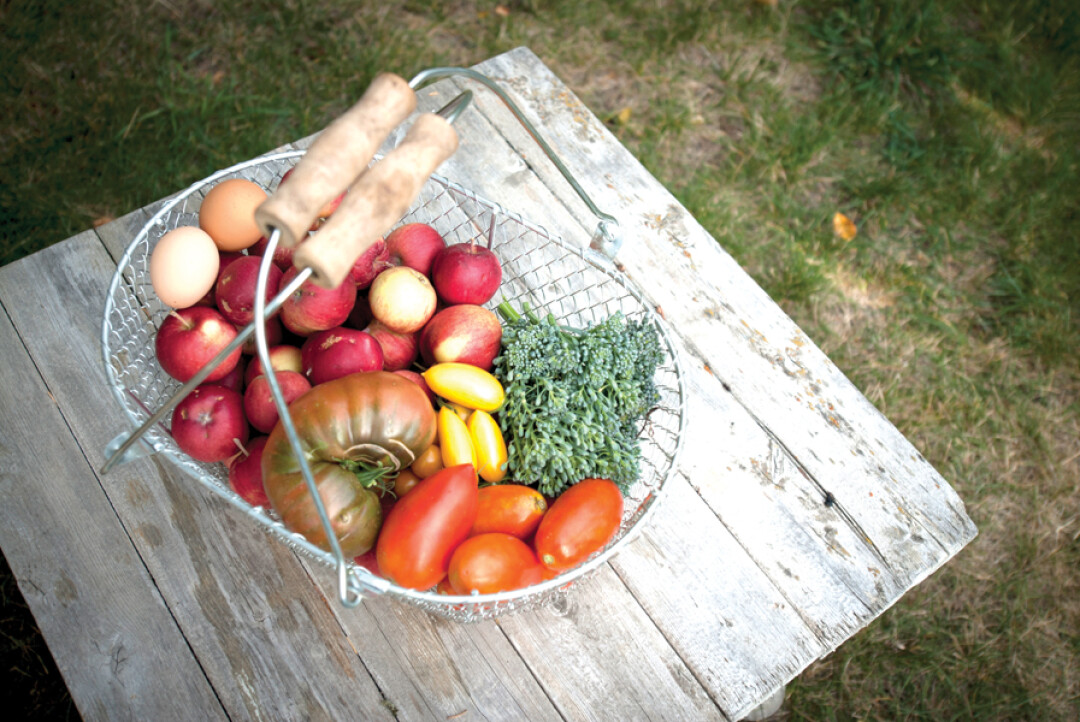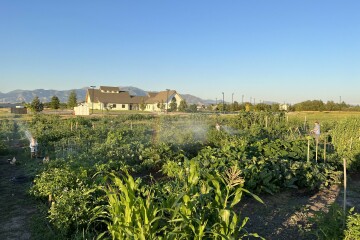What is Permaculture and Where it’s Happening in Bozeman
Permaculture Demystified
When I started my business, Broken Ground, back in 2011, one of my goals was to raise more awareness about permaculture in the Bozeman area. I quickly realized, however, that the greatest obstacle to that challenge was, in fact, the term. The word and accompanying explanations are so enveloped in jargon that it isn’t relatable.
Contrast that with the nods of enthusiasm I get when I mention edible landscapes or growing your own food, and I’ve realized that I have to think of a better, more approachable way of introducing the concept. Thankfully, organic gardening does provide a bridge to hearing about permaculture. Yet, permaculture goes way beyond just growing some vegetables in your backyard.
Co-originated by Australians Bill Mollison and David Holmgren in the 1970s, permaculture has almost as many definitions as it does practitioners, which is another issue. However, one of the simplest definitions is that it is a design approach for sustainable living and land use, rooted in the observation of natural systems. The word permaculture originally referred to “permanent agriculture” but has been expanded to include “permanent culture,” since the social aspects of a society are inherent to building a truly sustainable system.
By combining traditional knowledge with modern science, Permaculture provides a set of ethics and principles that teach us how to grow our own food and medicine, build natural homes, catch rainwater, harness energy, restore degraded landscapes, tend our animals, and build communities. The field of Permaculture gives us some of the most common sense, practical solutions to issues like soil degradation, food security and water pollution.
Permaculture adopts the philosophy of harmonizing with natural systems, and is guided by three ethics: care of the earth, care of people, and reinvesting surplus. While the first two ethics need no real explanation, the third ethic means that any surplus that you have in your system (e.g. resources, time, money, land) should be redistributed or reinvested back into the first two ethics. In other words, if you have extra garden veggies, give them to your friends or sell them at the market; if you have extra time, help your neighbor can her tomatoes; extra compost—donate it to the community garden.
Permaculture design can be applied at any scale—from a small backyard to a neighborhood to a 100-acre property. Whatever the scale, the goal is the same: designing ecologically sound and economically prosperous human communities.
A set of design principles has evolved to inform how you go about transforming your site or your community. Here are just a few examples:
Observe
If we observe natural systems and learn from them, we can positively design ourselves out of problems and into systems that create food, cycle nutrients, build soil, are self-renewing, and don’t produce waste. Observe your site through the seasons and harmonize with the patterns that are already occurring. Using “protracted and thoughtful observation rather than protracted and thoughtless action” is one of the main aims of permaculture. The more time you spend in the observation phase, the less time you will spend fighting natural forces and undoing your mistakes.
Catch and Store Energy
Identify what energies come onto your site (e.g. solar, water, wind). See yourself as setting up “interception nets” to capture as much of this renewable energy as possible before it passes from your property. Planting an orchard, a garden or saving seeds are all nets that capture and store solar energy. Rainwater barrels and rain gardens capture water off of your roof and can be used for vegetable gardens or perennial plantings. Finally, wind energy can be captured with a generator and used to power your home.
Every element performs multiple functions In permaculture, every element in your system (e.g. pond, greenhouse, chickens, compost pile) should perform multiple functions. For example, backyard chickens not only provide the homeowner with eggs, they can provide meat. Chickens also scratch up the ground and eat pests, their manure adds nutrients to the garden, and their feathers can be added to a compost pile. Beneficial connections between different elements in your yard create a more stable system.
Every function is supported by multiple elements If every element performs multiple functions, every function, in turn, should be supported by multiple elements. If one of the functions on your site is to harvest water, support that function by having rainwater barrels attached to your gutters. You might also excavate and plant a rain garden that collects runoff from your sidewalk or driveway. Using groundcovers amongst your perennials or mulching your garden between the rows encourages water infiltration and maintains soil moisture. Diversity, redundancy, and variation in a natural system increases that system’s ability to adapt and rebound during adverse conditions. If one element in your system fails, you will still have other elements that can harvest water. If you want your system to be as resilient as nature, then you must mimic the diversity of ways in which nature maintains and supports itself.
Permaculture in Bozeman
At its core, permaculture helps people become more self-reliant through the design of productive gardens, farms and communities. Its aim is to create resilient communities and relocalize economies. There are a lot of initiatives in Bozeman already. Some of the work is being called permaculture and some of it is under other names but follows the same principles.
Edible Properties
Every year, interest in Master Gardener courses and my Spring gardening workshops seems to increase. Not only are homeowners and renters planting vegetables, some are thinking about fruit trees and berry bushes. Setting up more perennial plantings, that come back year after year and take less work once established, gets us closer to a system of ‘permanent agriculture.’
Community Gardens
The city of Bozeman has three community gardens, at Langhor Park, Westlake Park, and behind City Hall. Plots function as a yearly rental space, which can be renewed year after year. This gives people who don’t have a yard the opportunity to grow some of their own food and to learn from other gardeners. In addition, Spring Creek Community Garden, which is privately owned, is an innovative gardening concept. Rather than having your own individual plot, Spring Creek has an in-ground greenhouse and is set up like a small farm. Its 30+ members collectively plant, maintain, harvest and preserve the vegetables that are then shared amongst them.
Community Networks
Through my business, I hold gathering once/month as a way to bring people together around growing food. Whether it’s potlucks during the growing season or film nights during the winter, these are opportunities for people to come together and create beneficial connections with one another. Just as the species in a forest create beneficial connections with one another, we can do the same in our human relationships.
The Montana Women of the Dirt is an e-mail group that has grown to over 200 women from south-central Montana who raise crops, food, and animals in an effort to better their own lives. Women of the Dirt members not only share information about growing food but actual resources like straw, manure, plants, and animals. It’s a beautiful network of like-minded women who also meet regularly for potlucks and gatherings.
Food Forests
A food forest is the concept of mimicking the architecture of a woodland ecosystem but instead incorporates fruit and nut trees, shrubs, herbs, vines and perennial vegetables. On a couple commercial properties just south of Kagy Boulevard on Fairway Drive, there are small food forests of fruit trees and berry bushes. Cherry, pear and plum trees are surrounded by gooseberries, raspberries, currants, strawberries, and rhubarb. Students from the Sustainable Foods and Bioenergy Systems program have also started to design and implement a food forest landscape on the North end of Townes Harvest Garden, along Garfield St. In addition, a small public food forest, one that would be open to the public for demonstration and harvest, is also planned for the new Story Mill Community Park in North Bozeman.
Farmers’ Markets
The Bozeman Winter Farmers’ Market, in addition to the two summer farmers markets at Bogert Park and the Gallatin County Fairgrounds are great examples of setting up more food secure communities. If you’re unable to grow some of your own food, there are so many options in our area for local vegetables, meat, cheese, grain, jams, and bread. Buying local at farmers markets, grocery stores and other local businesses is one of the best ways to foster a resilient local economy.
I live in North Bozeman, just south of a subdivision where new houses are popping up weekly as people continue to move to our city. Last year, Gallatin County pushed past the 100,000 resident mark. As a city, Bozeman already has several vibrant initiatives that promote and advance the goals of permaculture. As we see our population increase, however, using permaculture principles to design not only our properties but our community would go a long way in terms of making our region more food secure, livable, walkable, and sustainable.
